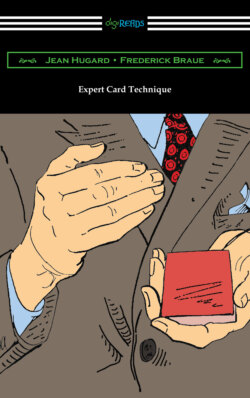Читать книгу Expert Card Technique - Jean Hugard - Страница 28
На сайте Литреса книга снята с продажи.
c. The Deal
Оглавление1. Push off the top card with the left thumb.
2. Bring up the right hand and place the first and second fingers, always acting as a unit, under the left forefinger so that this finger rests in the groove formed by the juncture of the right first and second fingers, Fig. 3. The tip of the left first finger rests at the outer joint of the right first finger; the right second finger is in the gap between the left first and second fingers. The flat surface of the right fingers is always parallel to the surface of the pack.
If this position is taken correctly, the flat first phalange of the right second finger presses lightly against the face of the bottom card at the right outer index, and the right thumb on the outer right corner of the top card which projects diagonally off the pack some three-fourths of an inch.
3. Draw the right hand to the right, simultaneously snapping the first joint of the second finger inwards, taking the bottom card with it. This card is then grasped between the right second finger and thumb, the right first finger still being held rigidly against the second finger, Fig. 4. In this figure the top card is being drawn back onto the pack by the left thumb as the bottom card is removed. The pack is shown face upwards for clarity.
This snapping action of the right second finger can be likened to the schoolboy’s action of snapping his fingers to attract the teacher’s attention; it is a quick sideways action of both right fingers with the bottom card playing the part of the thumb. This card is whipped out to the tips of the right fingers, passing over the left second, third and fourth fingers.
Up to the moment when the deal is begun these three left fingers have been curled gently at the right side of the pack; once the deal is started they are extended rigidly, the fingers being straight from the palm to the tips, Fig. 5. As the bottom card is withdrawn to the right, they drop as a unit a fraction of an inch to allow its passage; this movement is negligible and passes unnoticed if the fingers are held rigidly straight. If the fingers are not straight this dip becomes very noticeable; some work is required to get the knack of the flat fingers but it quickly becomes automatic.
4. The bottom card is dropped on the table to the right as, simultaneously, the left thumb draws the top card back squarely onto the pack. Some operators make the deal without any movement of the top card, the movement of the hands in dealing being considered sufficient cover for the sleight. Others, again, move the thumb to the right and back without disturbing the top card.
The reason for holding the right first and second fingers tightly together becomes apparent as soon as the procedure is followed; the forefinger masks the placing of the second finger at the bottom of the deck and, furthermore, makes the deal more natural in appearance. This latter point also applies to the curling of the right third and fourth fingers tightly against the palm.
A covering movement is made with the left wrist by some card conjurers, upwards to the right as the hand approaches to take a card, downwards as the card is taken, while others move both hands together as the card is taken, apart as the card is dealt. The object in each case is to conceal the movement of the left thumb in drawing back the top card.
Another method is to draw the right hand away with a long stroke instead of drawing back the left hand with the pack. Still another is that wherein the left hand, holding the pack, always follows the right hand, the deal apparently being made slowly. Each expert has evolved his own particular method of covering the action but the method explained above will be found easy to acquire and completely satisfactory.
